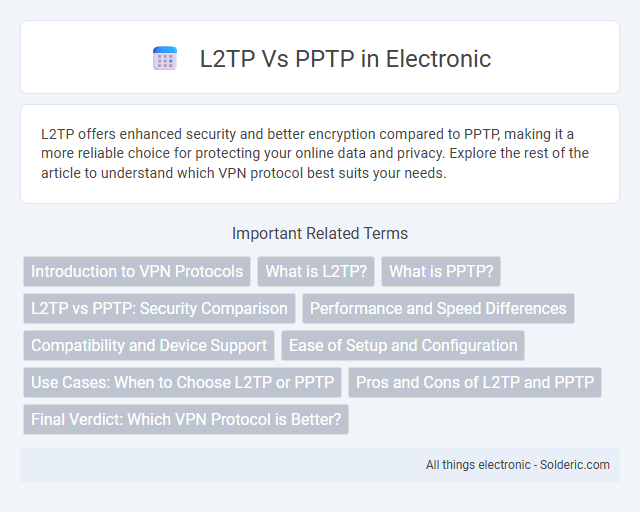L2TP offers enhanced security and better encryption compared to PPTP, making it a more reliable choice for protecting your online data and privacy. Explore the rest of the article to understand which VPN protocol best suits your needs.
Comparison Table
| Feature | L2TP (Layer 2 Tunneling Protocol) | PPTP (Point-to-Point Tunneling Protocol) |
|---|---|---|
| Security | High - Uses IPsec for encryption | Low - Basic, vulnerable to attacks |
| Encryption | Supports AES and strong encryption standards | Uses MPPE, weaker encryption |
| Compatibility | Widely supported across platforms | Supported by most legacy devices |
| Speed | Moderate - Due to encryption overhead | Fast - Low encryption overhead |
| Use Case | Secure VPN connections requiring privacy | Basic VPNs, legacy support |
| Port | UDP 500, UDP 1701, UDP 4500 | TCP 1723 |
| Reliability | More reliable with IPsec integration | Less reliable, prone to disconnections |
Introduction to VPN Protocols
L2TP (Layer 2 Tunneling Protocol) and PPTP (Point-to-Point Tunneling Protocol) are two prominent VPN protocols used to tunnel data securely over the internet. L2TP, often combined with IPsec for encryption, provides stronger security and better integrity checks compared to the older PPTP, which relies on the less secure MS-CHAP v2 authentication. While PPTP offers faster connection speeds and easier setup, L2TP is preferred for environments requiring robust encryption and reliable data confidentiality.
What is L2TP?
L2TP (Layer 2 Tunneling Protocol) is a VPN protocol that encapsulates data packets for secure transmission over the internet by combining features of PPTP and L2F. It does not provide encryption by itself, so it is often used with IPsec to ensure data privacy and integrity. Your VPN connection benefits from L2TP's strong compatibility with various devices and improved security compared to PPTP.
What is PPTP?
PPTP (Point-to-Point Tunneling Protocol) is a VPN protocol developed by Microsoft that enables secure data transmission over the internet by creating a virtual private network tunnel. Known for its simplicity and fast connection speeds, PPTP uses GRE (Generic Routing Encapsulation) to encapsulate PPP packets for transport across IP networks. Despite its ease of use, PPTP is considered less secure than modern VPN protocols due to vulnerabilities in its encryption methods.
L2TP vs PPTP: Security Comparison
L2TP (Layer 2 Tunneling Protocol) offers enhanced security compared to PPTP (Point-to-Point Tunneling Protocol) by combining with IPsec for encryption, making it more resistant to cyber threats and data breaches. PPTP, while faster and easier to set up, uses weaker encryption standards like MS-CHAPv2, which are vulnerable to brute-force attacks and interception. Your choice between L2TP and PPTP should prioritize strong encryption and data integrity, especially if security is a critical concern.
Performance and Speed Differences
L2TP offers stronger encryption but typically results in slower performance compared to PPTP due to its double encapsulation process, which adds overhead and latency. PPTP provides higher speeds by using less complex encryption protocols, making it suitable for applications where speed is prioritized over security. Users seeking better performance may prefer PPTP for streaming or gaming, while L2TP is favored for secure connections despite some speed compromise.
Compatibility and Device Support
L2TP offers broader compatibility across modern operating systems such as Windows, macOS, iOS, and Android, making it highly suitable for diverse device support. PPTP, while older and supported by many legacy devices, faces limitations on newer platforms due to security vulnerabilities and discontinued support. Choosing L2TP enhances your network's interoperability and ensures better device compatibility for secure VPN connections.
Ease of Setup and Configuration
L2TP offers a moderate level of ease in setup, requiring configuration of IPsec parameters alongside L2TP tunnels, which can be more complex for beginners. PPTP stands out for its simplicity, enabling quick VPN setup with minimal configuration steps and broad compatibility across devices. Your choice depends on balancing the need for straightforward installation with security and performance considerations.
Use Cases: When to Choose L2TP or PPTP
L2TP is ideal for secure corporate VPNs requiring strong encryption and data integrity, making it suitable for accessing sensitive business resources remotely. PPTP offers faster connection speeds with lower encryption, fitting for less critical scenarios like streaming content or bypassing geo-restrictions where maximum security is not a priority. Your choice between L2TP and PPTP should balance security needs against connection speed and compatibility requirements.
Pros and Cons of L2TP and PPTP
L2TP (Layer 2 Tunneling Protocol) offers stronger security through IPsec encryption, making it suitable for protecting sensitive data, but it may suffer from slower speeds and compatibility issues. PPTP (Point-to-Point Tunneling Protocol) provides fast connection speeds and broad device support, yet it is vulnerable to security breaches due to weaker encryption standards. Organizations seeking a balance between security and performance must weigh L2TP's enhanced encryption against PPTP's ease of use and speed.
Final Verdict: Which VPN Protocol is Better?
L2TP offers stronger encryption and better security compared to PPTP, making it more suitable for protecting sensitive data and maintaining privacy. PPTP provides faster connection speeds but lacks robust security features, leaving your online activities more vulnerable to interception. For a balanced choice prioritizing both security and performance, L2TP is generally the better VPN protocol.
L2TP vs PPTP Infographic

 solderic.com
solderic.com